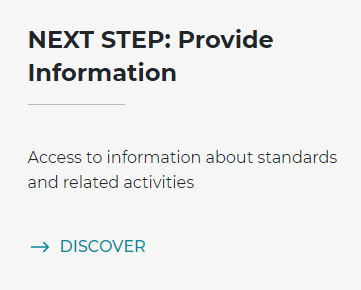Raise Awareness
Raise Awareness
Raising awareness about standardization is the first and most important step in the process of helping companies and organizations to become familiar with the world of standards.
An increased awareness of standards will help SMEs to understand how they can be used as tools to achieve their business objectives.
Why Should SMEs be aware of standards?
Because it will enable them to sell within the European Single Market or remain in a competitive position, to bring and receive current information about products, service etc. and to comply with regulations.
What can you do to raise awareness?
- Hold seminars
- Produce and distribute information materials (leaflets, etc.)
- Hold trainings and workshops (at national, regional and/or local levels)
- Include information in newsletters
- Provide information at trade fairs and other events attended by SMEs
- Develop dedicated web pages
- Use online collaboration tools
- Provide helpdesk services
- Make use of social media
Who should raise awareness?
- Standards organisations
- Business associations
- Chambers of commerce
- Sectoral organisations
- Governments and public authorities
How can this be achieved?
Efforts aimed at raising SMEs’ awareness of standardization should focus on their needs and the practical benefits for businesses of using standards.
Raising awareness requires investment in time and resources to explain and demonstrate how standards can be used in practice. Regional and/or local events are especially useful for reaching out to SMEs.
General information on standards and standardization should be combined with specific information and examples that are relevant for a particular audience.
More information on ways you can increase the awareness of SMEs on standardization:
Relevant information on standardization needs to be communicated to SMEs and other stakeholders repeatedly. Business associations and other organisations should be kept informed about recent and forthcoming developments regarding standards and standardization.
Good communication with stakeholders is the key to promoting standardization. A clear communication plan should include a number of different activities. Effective communication is very often a matter of repeating a message several times in different ways. It is therefore necessary to use a variety of communication tools and ensure a good timing of message delivery.
Communication should have a clear objective. Good knowledge of the target group(s) and of the potential impact and effectiveness of the different communication tools is essential. Messages should be developed from the perspective of the target audience and be explained in language that is easy to understand.
For example, using short film or video clips to promote standardization can be very effective as a way of communicating with potential customers. Videos can be published online and then shared on different websites, as well as via social media.
Standards organisations should aim to use a range of different communication tools, according to their own circumstances and the resources that are available to them.
Suitable tools and other means of communication could include the following:
- Information materials (leaflets, etc.)
- Information in newsletters
- Dedicated web pages
- Online collaboration tools
- Conferences and seminars
- Trainings and workshops (at national, regional and/or local levels)
- Information stands at trade fairs and other events attended by SMEs
- Helpdesk services
- Social media
- Videos
It is important to know which channels SMEs are using to find relevant information (business or trade associations, professional organisations, foreign investment and trade development agencies, specialist media, etc.).
Many SMEs rely on business associations to provide them with relevant information.
An effective solution is to provide these organisations with information, so they can inform SMEs about the relevance of standards and standardization.
Students are the standards users and decision makers of the future. Standardization and standards can be introduced via education modules and lectures to students at universities and other educational institutions. This provides an opportunity to raise awareness of standardization among the next generation of professionals.
When preparing education materials it is important to keep in mind the background and level of the target group, and to develop both general material on standards and standardization and more specialised material in relation to specific subjects.
The first steps to introduce standardization into tertiary and higher education are:
- establishing contacts with colleges and universities,
- defining objectives and content for the education modules,
- identifying qualified persons who can deliver lectures on standardization
